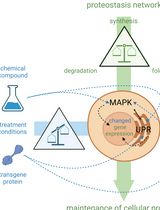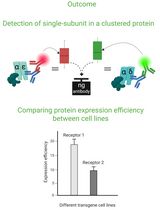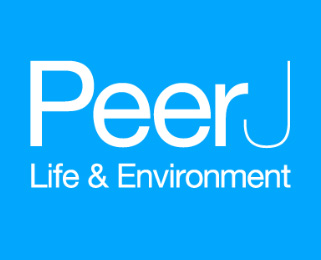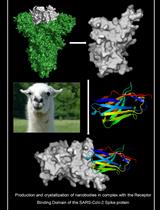- EN - English
- CN - 中文
A Detailed Protocol for Large-scale Recombinant Expression and Validation of Human FGFR2 with Its Transmembrane and Extracellular Domains in Escherichia coli
人FGFR2跨膜区域和胞外区域在大肠杆菌中的大规模重组表达和验证的详细方法
发布: 2019年06月05日第9卷第11期 DOI: 10.21769/BioProtoc.3261 浏览次数: 5734
评审: Alessandro DidonnaMichael Nguyen TrinhAli Asghar Kermani

相关实验方案

Cell-Sonar:通过特定蛋白标志物表达变化追踪目标蛋白的简便低成本方法
Sabrina Brockmöller [...] Simone Rothmiller
2025年02月05日 1610 阅读

Cluster FLISA——用于比较不同细胞系蛋白表达效率及蛋白亚基聚集状态的方法
Sabrina Brockmöller and Lara Maria Molitor
2025年11月05日 1130 阅读
Abstract
Receptor tyrosine kinases (RTKs) are an important class of transmembrane receptors that mediate some of the most crucial biochemical pathways essential to the growth, differentiation, and survival of a cell and thus, are highly involved in cancers. Due to the complexity of RTKs having biochemically different domains including a transmembrane domain, an intact crystal structure of any of these proteins remain elusive as it is difficult to produce milligram amounts of intact functional RTKs for crystallography studies. A heavily studied RTK is fibroblast growth factor receptor 2 (FGFR2), which plays a key role in fibroblast growth regulation, differentiation, and oncogenesis. Previous studies have focused on expressing FGFR2’s extracellular, transmembrane, and intracellular domains individually. For this protocol, we have focused on the extracellular and transmembrane domains of the FGFR2 protein. The function of the expressed protein is validated by demonstrating its ability to bind heparin and fibroblast growth factor 1 (FGF1). The primary contribution of our protocol is expressing two RTK domains together, including the transmembrane domain, in milligram quantities. Being able to express RTKs to define its crystal structures would enable pharmacologists to design cancer drugs that selectively target active conformations.
Keywords: Receptor tyrosine kinase (受体酪氨酸激酶)Background
Receptor tyrosine kinases have eluded scientists in the quest for an intact fully functional crystal structure. In general, transmembrane proteins have been highly challenging to conduct structural studies especially due to challenges with expressing large quantities of fully functional protein. While most studies of FGFR expression focus on crystallizing the extracellular receptor or tyrosine kinase domain separately, working with the transmembrane domain linked to either of the two domains can result in multiple biochemical challenges (Mohammadi et al., 1996; Plotnikov et al., 1999; Plotnikov et al., 2000; Schlessinger et al., 2000; Yeh et al., 2002; Zhang et al., 2009). These eukaryotic transmembrane proteins, when expressed in high quantities in E. coli are usually highly unstable and often precipitate out of solution or aggregate (Rosano and Ceccarelli, 2014b). Moreover, RTKs have three functionally and structurally distinct domains, making it difficult to optimize expression because each domain may function optimally in different conditions. Detergent must always be used to keep the protein soluble due to the hydrophobic nature of the transmembrane domain (Rosano and Ceccarelli, 2014a). Host cells heavily regulate the expression of protein kinases due to their roles in activating important pathways. As a result, overexpression of these proteins to produce significant quantities may be toxic to leading to inclusion bodies and degradation. We chose FGFR2, a receptor responsible for activating complex mechanisms that result in angiogenesis, skeletal formation, and cell proliferation, and growth, as the best candidate for structural studies based on preliminary small-scale expression experiments (Turner and Grose, 2011).
A primary goal of expressing functional FGFR in significant quantities (milligrams) is for X-ray crystallography. Two to fifty milligrams of protein is typically necessary for X-ray crystallography (Dessau, and Modis, 2011). A crystal structure would greatly facilitate the design of that selectively target the receptor. While there are studies that have determined the crystal structure of the FGFR2 ECD, TM, and intracellular kinase domains separately, they do not tell us the mechanism by which the external signal is transduced to the intracellular kinase domain. While the approach described in this paper does not describe expression of the entire protein, it does provide an important starting point by describing the expression of two linked domains including the technically challenging transmembrane domain. Recently, there have been a few studies that have demonstrate successful recombinant expression of EGFR, EphA2, PDGFR, and Kit (Mi et al., 2008 and 2011; Lu et al., 2012; Paavilainen et al., 2013; Opatowsky et al., 2014; Chen et al., 2015). However, none of these studies employed E. coli as a host and described production of protein quantities sufficient for X-ray crystallography studies. We hope our methods will contribute to the ongoing effort towards crystallizing the structure of an intact receptor tyrosine kinase.
The determination of the crystal structure for intact FGFR2 would greatly facilitate drug discovery. FGFR drugs may potentially be used to treat a multitude of cancers including breast, stomach, lung, bladder, osteosarcoma, and intrahepatic cholangiocarcinoma (Babina and Turner, 2017). In addition, there is the potential for pharmacological in-utero treatment of FGFR2 associated craniosynostosis syndromes such as Apert Syndrome, Pfieiffer syndrome, and Bear-Stevenson syndrome (Robin et al., 2011). Overall, crystallizing an intact FGFR2 may also set a precedent for the crystallization of intact receptor tyrosine kinases, including other FGFRs, which are key drug targets.
Materials and Reagents
- Pipette tips (VWR, Next Generation Low-Binding, catalog numbers: 89076-476, 89076-486)
- SnakeskinTM membrane (Thermo Fisher Scientific, catalog numbers: 68035, 88244)
- Superdex S200 10/300 GL size exclusion chromatography column (GE Healthcare)
- HiTrap Heparin Affinity Chromatography Column (GE Healthcare, catalog number: 17040601)
- SnakeSkinTM Dialysis Clips (Thermo Fisher Scientific, catalog number: 68011)
- PVDF membrane (Thermo Fisher Scientific, catalog number: 88518)
- 1.5 ml centrifuge tubes (Fisher Scientific, catalog number: 05-408-129)
- 3 ml syringes, Luer lock (Becton Dickinson, catalog number: BD309657)
- Petri Dishes for LB Plates, 100 x 10 mm (VWR, catalog number: 25384-324)
- pSpeedET vector, DNASU plasmid repository (EvNO00285791)
Note: pSpeedET must have N-terminal E. coli maltose binding protein (MBP) fusion tag. - Lemo21 (DE3) Competent E. coli (New England Biolabs® Inc., catalog number: 2528J)
- Primers
31F: 5’ ctgtacttccagggcACCACATTAGAGCCAGAAGGAGCAC 3’
406R_noGFP: 5’ gtttaattaagtcgcgtta CTTCTTGGTCGTGTTCTTCATTCGGC 3’ - Phusion® High-Fidelity PCR Kit (New England Biolabs® Inc., catalog number: C2528J)
- ThermoScientific GeneJET Gel Extraction Kit (Thermo Fisher ScientificTM, catalog number: K0691)
- General Electric Healthcare illustraTM plasmidPrep Mini Spin Kit (GE Healthcare, catalog number: GE28-9042-69)
- Dimethylsulfoxide (DMSO) (Sigma-Aldrich, catalog number: D650-5X5 ML)
- Agarose (Lonza SeaKem LE, catalog number: 50004)
- SOC recovery media (Thermo Fisher Scientific, catalog number: 15544034)
- Kanamycin (Research Productions International, catalog number: K22000)
- Chloramphenicol (Research Productions International, catalog number: C61000)
- Carbenicillin (Research Productions International, catalog number: C46000)
- Terrific broth (TB) (Sigma Aldrich, catalog number: T0918)
- Beta-D-1-thiogalactopyranoside (IPTG) (Sigma-Aldrich, catalog number: l6758-1G)
- DNase I (New England Biolabs, catalog number: M0303S)
- CaCl2 (Fisher Scientific, catalog number: AC349610250)
- Benzamidine (Sigma-Aldrich, catalog number: 449709)
- PMSF (Sigma-Aldrich, catalog number: 10837091001)
- Protease Inhibitors E-64 (Sigma-Aldrich, catalog number: E3132)
- Pepstatin (Sigma-Aldrich, catalog number: P5318-5MG)
- Bestatin (Sigma-Aldrich, catalog number: B8385-1MG)
- β-mercaptoethanol (BME) (Sigma-Aldrich, catalog number: M6250)
- e2TAK polymerase (Takara Bio, catalog number: RF001A)
- Rapid Transfer Buffer, 10x (VWR® Amresco® Life Science, catalog number: N789-1L)
- Anti-MBP Antibody (New England Biolabs, catalog number: E-8038)
- Tris-glycine gels 8-16% (NuSep, catalog number: NG15-816)
- n-dodecyl-β-D-maltoside DDM (Anatrace, catalog number: D310)
- KPL TMB Membrane Peroxidase Substrate System Kit (Sera Care, catalog number: 5420-0025)
- Amresco RapidBlockTM solution (VWR, catalog number: 97064-124)
- NaCl (Sigma-Aldrich, catalog number: S9888)
- HEPES at pH 7.5 (VWR, catalog number: 97061-822)
- MgSO4 (Sigma-Aldrich, catalog number: M7506)
- Glycerol (Sigma-Aldrich, catalog number: G9012)
- Tris-HCl pH 7.5 (Sigma-Aldrich, catalog number: 10812846001)
- Tween 20 (Sigma-Aldrich, catalog number: P9416)
- Guanidinium-HCl (Sigma-Aldrich, catalog number: G3272)
- Dithiothreitol (DTT) (Sigma Aldrich, catalog number: DTT-RO)
- L-cysteine (Sigma-Aldrich, catalog number: 168149)
- Imidazole (Alfa Aesar, catalog number: AA47274)
- Gel Green® (Biotium, catalog number: 41005)
- LB agar (VWR, catalog number: 97064-106)
- NEB® 5-alpha Competent E. coli (High Efficiency) DH5α cells (New England Biolabs, catalog number: C2987l)
- Coomassie Brilliant Blue (Thermo Fisher Scientific, catalog number: 20279)
- FGF1 pMCSG7 plasmid (DNASU plasmid repository, catalog number: HsCD00343156)
- HRP-conjugated anti-MBP antibody (New England Biolabs, catalog number: E8038)
- Milk Powder
- Lysis Buffer (see Recipes)
- TBST (see Recipes)
- Denaturing buffer dialysis solution #1 (see Recipes)
- Dialysis Solution #2 (see Recipes)
- Binding buffer for heparin affinity chromatography (see Recipes)
- Elution buffer for heparin affinity chromatography (see Recipes)
- Elution buffer for FGF1 (see Recipes)
- Running Buffer for SEC (see Recipes)
- Blocking Buffer (see Recipes)
Equipment
- Baffled, 125 ml Erlenmeyer flasks (Sigma-Aldrich, catalog number: CLS4444125)
- Pipettes (Gilson, Pipetman Classic)
- Centrifuge for collecting liters of cell culture (Thermo Fisher, Sorvall, catalog number: ST16)
- Tabletop microcentrifuge (Eppendorf, model: 5415)
- PCR Thermal cycler (Thermo Scientific, model: Hybaid PX2 Gradient Thermal Cycler)
- Sonicator (Thermo Fisher, model: 550 Sonic Dismembrator)
- Akta Purifier or FPLC (GE Healthcare, AKTA Purifier 100 FPLC, Frac-950)
- Refrigerated shaker/incubator for growing cells (New Brunswick, Innova 4230 Refrigerated Incubator)
- Vortexer (Fisher Scientific, catalog number: 02215365)
- JA20 Fixed-Angle Aluminum rotor Biosafety Lid- 8 x 50 ml, 20,000 rpm, 48,400 x g (Beckman Coulter, catalog number: 334831)
- Magnetic stir bar (Fisher Scientific, catalog numbers: 14-513-83, 14-513-93, 14-513-95, 14-513-94)
- Peristaltic pump (Gilson, Rabbit Plus)
- Visible/UV spectrophotometer (Cary 50)
- Test tube rotator (Scientific Equipment, model: 60448 Test Tube Rotator)
- Western Blot apparatus (Bio-Rad)
- Clare Dark Reader Transilluminator (Clare Chemicals, DR46)
Software
- ApE (A plasmid Editor) program for nucleotide analysis (http://jorgensen.biology.utah.edu/wayned/ape/)
- NCBI BLASTn for sequence comparison (https://blast.ncbi.nlm.nih.gov/Blast.cgi?PAGE_TYPE=BlastSearch&BLAST_SPEC=blast2seq&LINK_LOC=align2seq)
Procedure
文章信息
版权信息
© 2019 The Authors; exclusive licensee Bio-protocol LLC.
如何引用
Bajinting, A. and Ng, H. L. (2019). A Detailed Protocol for Large-scale Recombinant Expression and Validation of Human FGFR2 with Its Transmembrane and Extracellular Domains in Escherichia coli. Bio-protocol 9(11): e3261. DOI: 10.21769/BioProtoc.3261.
分类
生物化学 > 蛋白质 > 表达
您对这篇实验方法有问题吗?
在此处发布您的问题,我们将邀请本文作者来回答。同时,我们会将您的问题发布到Bio-protocol Exchange,以便寻求社区成员的帮助。
Share
Bluesky
X
Copy link










